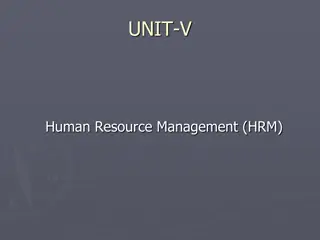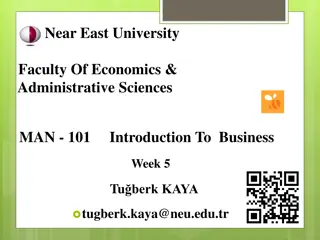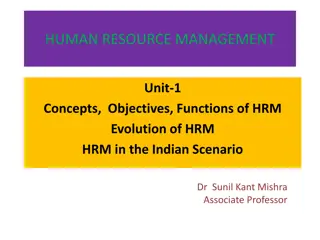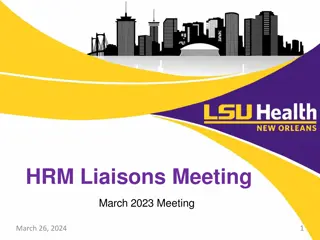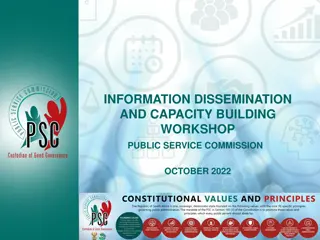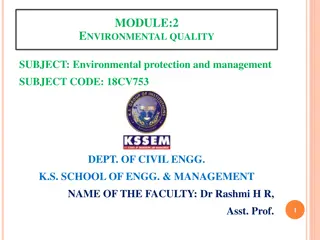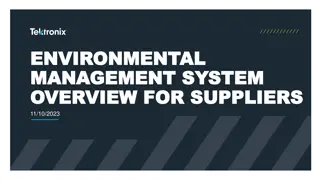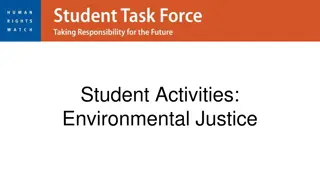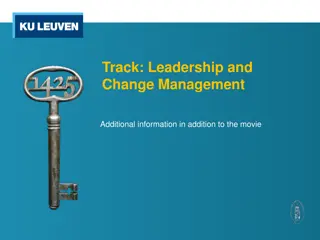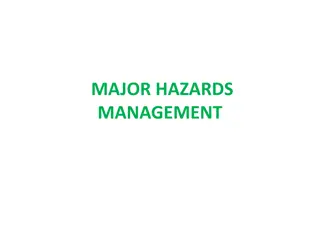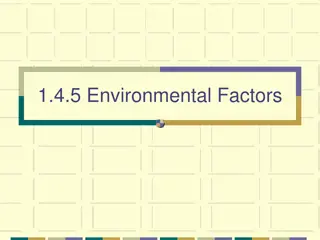Understanding Environmental Factors in HRM Management
A diagnostic model in HRM framework assists managers in analyzing and solving HRM-related problems by focusing on factors like job design, performance evaluation, benefits, and organizational values. Managers need a profound understanding of internal and external environments to make informed decisions that impact HRM practices. The totality of factors influencing an organization and its HRM practices is termed the HRM environment, consisting of external forces beyond management's control and internal concerns. Strategic challenges in HRM include investing in HR professionalism, managing people effectively, adapting to evolving HRM roles, shaping organizational culture, and attracting a skilled and motivated workforce.
Download Presentation

Please find below an Image/Link to download the presentation.
The content on the website is provided AS IS for your information and personal use only. It may not be sold, licensed, or shared on other websites without obtaining consent from the author. Download presentation by click this link. If you encounter any issues during the download, it is possible that the publisher has removed the file from their server.
E N D
Presentation Transcript
H U M A N R E S O U R C E M A N A G E M E N T E N V I R O N M E N T CHAPTER TWO
A DIAGNOSTIC MODEL IN HRM FRAMEWORK Is a framework that can be used to help managers focus on a set of relevant factors to analyze and solve HRM related problems. It is based on the assumption that HR activities are all related to each other and have a combined effect on people. Example: factors- properly designed job, performance evaluation system, relevance and attractiveness of benefits,organizational values
A DIAGNOSTIC MODEL IN HRM FRAMEWORK The management must have a deep understanding and appreciation of the internal and external environments. It is desirable that managers know what the environment is and how it influences HRM functions in an organization. Managers must always be aware of the environmental forces influencing their decisions; at the same time, they must be aware of how their decisions may affect the environment.
REFLECTION What is the difference between internal and external environment? Give examples. How does the environmental factors affect HRM practices of an organization? 5
THE ENVIRONMENTAL FACTORS AFFECTING HRM THE ENVIRONMENTAL FACTORS AFFECTING HRM 6
HRM ENVIRONMENT Environment is the totality of factors that influence an organization and its sub systems such HRM. External Environment -forces external to a firm that affect the firm s performance but are beyond the control of management. In order to adopt to the external environment constant monitoring of the external environment for opportunities and threats is important. Internal Environment- are concerns or problems internal to the organization.
STRATEGIC ISSUES (CHALLENGES) FACING HRM Invest on HR professionalism and professionals; Understanding and Managing people; How to find, motivate , nurture, develop and keep them Learn and adapt to evolving role of HRM; Discern, create, and adapt organizational culture; Availing Skilled and motivated workforce;
STRATEGIC ISSUES (CHALLENGES) FACING HRM See HR as a decision science and bring discipline to it; HRM is not a random set of events, but a disciplined set of choices Responding strategically to changes in the market place; Requires continuous monitoring for pressing competitive issues of the organization Advancing HRM with technology;
STRATEGIC ISSUES (CHALLENGES) FACING HRM Managing knowledge workers Maintain cost while retaining top performing employees Managing workforce diversity Globalization
READING ASSIGNMENT Read about international human resource management Armstrong page 99
INTERNATIONAL HUMAN RESOURCE MANAGEMENT (IHRM) IHRM is the process of employing, developing and rewarding people in international or global organizations. IHRM is human resource management issues, functions and policies and practices that result from the strategic activities of multinational enterprises and that impact on the international concerns and goals of those enterprises
WHY STUDY IHRM? Effective HRM is one of the major determinant of success or failure in international business The availability of internationally experienced managers has significant contribution for the successful implementation of global strategies Expatriate failures continue to be a significant problem for many international firms
HRM POLICY ISSUES HRM POLICY ISSUES 1. From where to hire people with the right competence for the international operations. Whether to use local nationals or expatriates Expatriates are people who are the nationals of the parent company or who have third-country nationality.
local nationals or expatriates LOCAL NATIONAL EXPATRIATES are familiar with local markets, communities, the cultural setting and the local economy speak the local language and are culturally assimilated can take a long-term view and contribute for a long period do not take the patronizing (neo- colonial) attitude Relatively cheaper labor provide expertise that local nationals lack cost three or four times local nationals Have short term perspective the experience and
HRM POLICY ISSUES HRM POLICY ISSUES 2. Recruitment and selection issues Specifying role requirements:- behavior s required for those who work internationally Examples tolerate and adjust to local conditions gain acceptance as a representative of one s company abroad inform and communicate effectively with a foreign environment about the home company s policies take into account the foreign environment when negotiating contracts and partnerships
HRM POLICY ISSUES HRM POLICY ISSUES Providing realistic previews about the job assignment such as :- About the overseas operation Any special features of the work How to adjust to local conditions Career progression options Re-entry policy on completion of the assignment Pay and benefits cultural familiarization sessions
HRM POLICY ISSUES HRM POLICY ISSUES 3. Training need analysis (in terms of skill and cultural requirements of the assignment) set training goals Develop training course Evaluate success
HRM POLICY ISSUES HRM POLICY ISSUES 3. Performance management issues Assimilations review to assess the potential and ability of individuals to cope with overseas conditions
HRM POLICY ISSUES HRM POLICY ISSUES 4. Pay and allowances policies 4.1 Home based pay the value of the salary of expatriates is the same as in their home country 4.2. The host-based pay expatriates are paid salaries and benefits that are in line with those given to nationals of the host country in similar jobs. Allowances can be hardship, housing, school fee .holiday , company cars
HRM POLICY ISSUES HRM POLICY ISSUES 5. Should we have the same HR policies for all firms?(global /local dilemma) converge worldwide to be basically the same in each location, or diverge to be differentiated in response to local requirements.
local factors that influence strategic choices Local Conditions Parent- Company Strategy Ethnocentric Global The workforce doesn t enjoy much power Unskilled and uneducated workforce Scare job opportunities high unemployment rate Employees are young with little or no experience No well established organizational culture Subsidiary located in a developing country and less advanced in technical management issues and professional
local factors that influence strategic choices Local Conditions Parent- Company Strategy Polycentric Highly skilled and educated workforce Employees are aware of their rights Pro-workers rules and regulations Low unemployment rate Economic boom Subsidiary located in a technically and professionally advanced industrialized country
HOW TO DEVELOP INTERNATIONAL APPROACH An explicit recognition by the parent organization that :- Its own peculiar ways of managing human resources reflect some of the assumptions and values of its home culture. its foreign subsidiaries may have other preferred ways of managing people that are neither intrinsically better nor worse, but could possibly be more effective locally. genuine belief that more creative and effective ways of managing people could be developed as a result of cross-cultural learning. acknowledge, discuss and make useable cultural differences
THE LEGAL ASPECTS OF HRM Understanding and complying with HR law is important for three reasons:- To do the right thing Realize the limitations of firm s HR Minimize firm s potential liability
EQUAL EMPLOYMENT OPPORTUNITY (EEO) Is the condition in which all individuals have an equal chance for employment, regardless of their race, color, religion, sex, age, disability, or national origin. The treatment of individuals in all aspects of employment in a fair and nonbiased manner.
EQUAL EMPLOYMENT OPPORTUNITY EEOdemands the practice of reasonable accommodation which refers to an attempt by employers to adjust, without unnecessary hardship, the working conditions or schedules of employees with disabilities or religious preferences.
DISCRIMINATION IN THE WORKPLACE Discrimination is defined us the making of distinctions among people.
DISPARATE TREATMENT One sign of discrimination is disparate treatment differing treatment of individuals, where the differences are based on the individuals race, color, religion, sex, national origin, age, or disability status. Example:- hiring or promoting one person over an equally qualified person because of the individual s race. Failing to hire women with school-age children but hiring men with school-age children.
TO AVOID DISPARATE TREATMENT Evaluating interview questions and decision criteria to make sure they are job related
AFFIRMATIVE ACTION A strategy intended to achieve fair employment by urging employers to hire certain groups of people who were discriminated against in the past. An organization s active effort to find opportunities to hire or promote people in a particular group. taking extra effort to attract and retain minority employees. Affirmative action measures are temporary interventions
AFFIRMATIVE ACTION AND ETHIOPIAN LAW Article 35 The historical legacy of inequality and discrimination suffered by women in Ethiopia taken into account, women, in order to remedy this legacy, are entitled to affirmative measures. The purpose of such measures shall be to provide special attention to women so as to enable them to compete and participate on the basis of equality with men in political, social and economic life as well as in public and private institutions.
AFFIRMATIVE ACTION AND ETHIOPIAN LAW Proclamation 515/2007 In recruitment promotion and deployment preference shall be given to: female candidates candidates with disabilities; and members of nationalities comparatively less represented in the government office, having equal or close scores to that other candidates.
HARASSMENT IN THE WORKPLACE Sexual Harassment Unwelcome advances, requests for sexual favors, and other verbal or physical conduct of a sexual nature in the working environment Sexual harassment includes any type of behavior, comments, gestures, and actions of a sexual nature that create a hostile work environment for an employee.
ACTIVITY What can you do as a human resource manager to deal with harassment in the workplace ?
HOW TO DEAL WITH HARASSMENT Have clear well communicated harassment prohibiting policy Definition of sexual harassment (physical conduct, verbal conduct & non-verbal conduct) Training and refreshment training programs Compliant procedure Disciplinary measures (from warning to dismissal) In place effective complaint procedure Guard against retaliation Quickly investigate all claims Take remedial action to correct past harassment Follow up to prevent continuation of harassment
READING ASSIGNMENT Read about job analysis Scott, S. A. & Bohlander , G. W., 2012. Managing human resource.


